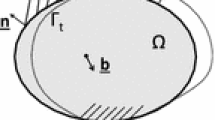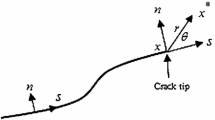Abstract
The paper deals with a numerical treatment of the dynamic hemivariational inequality problem concerning the elastoplastic-fracturing unilateral contact with friction between neighboring structures under second-order geometric effects during earthquakes. The numerical procedure is based on an incremental problem formulation and on a double discretization, in space by the finite element method and in time by the Houbolt method. The generally nonconvex constitutive contact laws are piece-wise linearized, and in each time-step a nonconvex linear complementarity problem is solved with a reduced number of unknowns.
Similar content being viewed by others
References
Anagnostopoulos, S.A. and Spiliopoulos K.V (1991), Analysis of Building Pounding due to Earthquakes. In: Krätzig W.B. et al (eds.), Structural Dynamics, pp. 479-484, Balkema, Rotterdam.
Anastasiadis, K. (1986), Méthode simplifiée de calcul du second ordre de bâtiments à étage, Construction Metallique 4: 43-68.
Baniotopoulos, C.C. (1995), Optimal control of above-ground pipelines under dynamic excitations, Int. Jnl. Pressure Vessel & Piping 63: 211-222.
Bertero, V.V. (1987), Observations on structural pounding. Proc. Intern. Conf. The Mexico Earthquakes, ASCE, 264-278
Bisbos, C. (1985), Aktive Steuerung erdbebenerregter Hochhäuser, Z. Angew. Math. Mech. (ZAMM) 65: T297-9.
Chen, W.F. and Lui, E.M. (1981), Structural Stability, Elsevier, New York.
Dem'yanov, V.F., Stavroulakis, G.E., Polyakova, L.N. and Panagiotopoulos+, P.D. (1996), Quasidifferentiability and nonsmooth modelling in mechanics, engineering and economics, Kluwer Academic, Dordrecht, Boston, London.
Haslinger, J. and Neittaanmäki, P. (1996), Finite element approximation for optimal shape, material and topology design, Wiley, Chichester (2nd edition).
Klarbring, A. (1986), General contact boundary conditions and the analysis of frictional systems. Int. J. Solids Structures, 22: 1377-1398.
Liolios, A.A. (1984), A finite-element central-difference approach to the dynamic problem of nonconvex unilateral contact between structures. In: B. Sendov, R. Lazarov and P. Vasilevski (eds.), Numerical Methods and Applications, pp. 394-401. Bulgarian Acad. Sciences, Sofia.
Liolios, A.A. (1989), A linear complementarity approach to the nonconvex dynamic problem of unilateral contact with friction between adjacent structures. Z. Angew. Math. Mech. (ZAMM) 69: T 420-T 422.
Maier, G. (1971), Incremental Elastoplastic Analysis in the Presence of Large Displacements and Physical Instabilizing Effects, Int. Jnl. Solids and Structures 7: 345-372.
Maier, G. (1973), Mathematical programming methods in structural analysis. In: Brebbia, C. & H. Tottenham (eds.), Variational methods in engineering, Proc. Int. Conf. Southampton University Press, Southampton, Vol. 2, 8/1-8/32.
Miettinen, M., Mäkelä M.M. and Haslinger, J. (1995), On mumerical solution of hemivariational inequalities by nonsmooth optimization methods, Journal of Global Optimization 6: 401-425.
Mistakidis, E.S. and Stavroulakis, G.E. (1998), Nonconvex Optimization in Mechanics: Algorithms, Heuristics and Engineering Applications, Kluwer Academic, Dordrecht, Boston, London.
Naniewicz, Z. and Panagiotopoulos, P.D. (1995), Mathematical Theory of Hemivariational Inequalities and Applications, Marcel Dekker, New York.
Nitsiotas, G. (1971), Die Berechnung statisch unbestimmter Tragwerke mit einseitigen Bindungen, Ingenieur-Archiv 41: 46-60.
Panagiotopoulos=, P.D., (1983), Non-convex Energy Functions. Hemivariational Inequalities and Substationarity principles, Acta Mechanica 48: 111-130.
Panagiotopoulos=, P.D. (1984), Optimal control of structures with convex and nonconvex energy densities and variational and hemivariational inequalities, Eng. Struct. 6: 12-18.
Panagiotopoulos=, P.D. (1985), Inequality problems in mechanics and applications. Convex and nonconvex energy functions, Birkhäuser Verlag, Boston-Basel-Stuttgart.
Panagiotopoulos=, P.D. (1993), Hemivariational Inequalities. Applications in Mechanics and Engineering. Springer-Verlag, Berlin, New York.
Papadrakakis, M., Apostolopoulou, K., Bitzarakis, S. and Zacharopoulos, A. (1993), A 3D model for the analysis of building pounding during earthquakes. In: Moan, T. et al., (eds.), '93, pp. 85-92, Balkema, Rotterdam.
Pardalos, P. (1991), Global Optimization Algorithms for Linearly Constrained Indefinite Quadratic Problems, Computers Math. Applic. 21(6/7): 87-97.
Pfeiffer, F. and Glocker, Ch. (1996), Multibody Dynamics with Unilateral Contacts, Wiley, New York.
Stavroulakis, G.E. (in press), Quasi-variational inequalities. In: Floudas, C.A. and Pardalos, P.A. (Eds.), Encyclopedia of Optimization, Kluwer Academic, London.
Stavroulakis, G.E., Antes, H. and P.D. Panagiotopoulos= (1999), Transient elastodynamics around cracks including contact and friction, Compo Meth. in Appl. Mech. and Enging., Special Issue: Computational Modeling of Contact and Friction, Eds.: I.A.C. Martins and A. Klarbring, 177(3/4), 427-440.
Stavroulakis, G.E. and Mistakidis, E.S. (in press), Nonconvex Energy Functions: Hemivariational Inequalities. In: Floudas, C.A. and Pardalos, P.A. (Eds.), Encyclopedia of Optimization, Kluwer Academic, London.
Talaslidis, D. and P.D. Panagiotopoulos=, (1982), A linear finite element approach to the solution of the variational inequalities arising in contact problems of structural dynamics. Int. J. Num. Meth. Enging., 18: 1505-1520.
Tzaferopoulos, M.A. and Liolios, A.A. (1997), On a Branch and Bound Algorithm for the Solution of a Family of Softening Material Problems of Mechanics with Applications to the Analysis of Metallic Structures, Journal of Global Optimization 11: 133-149.
Wolf, J.P. and Skrikerud, P.E. (1980), Mutual pounding of adjacent structures during earthquakes. Nuclear Engin. Design 57: 253-275.
Zacharenakis, E.C. (1997), On the Disturbance Attenuation and H∞-Optimization in structural analysis, Z. Angew. Math. Mech. (ZAMM) 77: 189-195.
Author information
Authors and Affiliations
Rights and permissions
About this article
Cite this article
Liolios, A. A Linear Complementarity Approach for the Non-convex Seismic Frictional Interaction between Adjacent Structures under Instabilizing Effects*. Journal of Global Optimization 17, 259–266 (2000). https://doi.org/10.1023/A:1026789817828
Issue Date:
DOI: https://doi.org/10.1023/A:1026789817828




